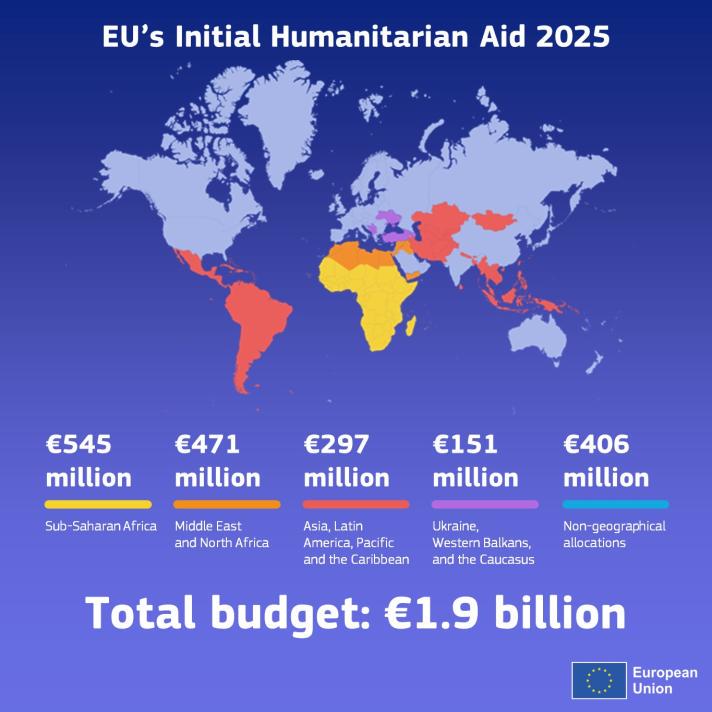European Union Humanitarian Aid Funding Map 2025


David Chen
Data Visualization Specialist
David Chen is an expert in transforming complex geographic datasets into compelling visual narratives. He combines his background in computer science ...
Geographic Analysis
What This Map Shows
The "European Union Humanitarian Aid Funding Map 2025" provides a visual representation of the initial funding allocations for humanitarian aid by the European Union. It highlights the amounts designated for various regions, showcasing the EU's commitment to addressing humanitarian crises around the world. As we delve deeper into this topic, it's essential to understand the importance of humanitarian aid, the mechanisms of funding, and the regions that are prioritized in efforts to alleviate suffering.
Deep Dive into Humanitarian Aid Funding
Humanitarian aid is critical for responding to emergencies caused by natural disasters, conflict, or other crises. The European Union, through its Civil Protection and Humanitarian Aid Operations (ECHO), plays a vital role in delivering assistance to vulnerable populations. In 2025, the EU's funding focuses on various sectors, including food security, healthcare, education, and shelter.
Interestingly, the EU’s humanitarian aid is not just about immediate relief; it also emphasizes long-term recovery and resilience. For instance, funding directed toward education helps children in crisis zones continue their schooling, which is essential for rebuilding communities post-conflict or disaster. In 2025, the EU has allocated significant resources for both immediate relief efforts and sustainable development projects, reflecting a holistic approach to humanitarian assistance.
What’s fascinating is how the EU prioritizes funding based on the severity of crises and the potential for impact. For example, regions experiencing prolonged conflicts, such as Syria and Yemen, receive substantial funding due to the ongoing humanitarian emergencies. In contrast, areas recovering from natural disasters might receive aid tailored to rebuilding infrastructure and support services.
The funding amounts can vary widely based on the situation. In 2025, regions like Sub-Saharan Africa and the Middle East are expected to receive the highest allocations due to the complex challenges they face. According to reports from ECHO, these regions are grappling with high levels of food insecurity, displacement, and health crises, making them top priorities for the EU's humanitarian efforts.
Regional Analysis
Analyzing the map, we can see distinct regional patterns in funding allocations. For instance, Eastern Europe and the Balkans are projected to receive comparatively lower amounts than regions facing active conflict or severe humanitarian crises. This disparity raises questions about the EU's strategic priorities and the long-term implications for stability in those areas.
In the Middle East, countries like Lebanon and Jordan, which host large numbers of refugees, are expected to receive substantial support. This funding is crucial for providing basic services and integrating refugees into local communities. In contrast, regions in Central Asia may receive less funding, reflecting a different set of geopolitical priorities and humanitarian needs.
One notable example is the funding for Turkey, which has been a key player in hosting Syrian refugees. The EU has committed significant resources to support Turkey's efforts in providing for these displaced populations, indicating a focus on regional stability and cooperation.
Conversely, countries in the Sahel region of Africa, such as Niger and Mali, are likely to see increased funding due to the escalating humanitarian crises driven by conflict and climate change. The EU’s commitment to these regions underscores the interconnectedness of humanitarian aid and broader issues like migration, security, and climate resilience.
Significance and Impact
The significance of the EU's humanitarian aid funding cannot be overstated. It directly impacts millions of lives by providing essential services and support to those in need. As the world faces increasing challenges from climate change, conflict, and pandemics, the demand for humanitarian assistance is likely to grow. Projections indicate that the EU will need to adapt its funding strategies to address these evolving challenges effectively.
Moreover, humanitarian aid serves as a tool for diplomacy and international relations. By committing resources to alleviate suffering, the EU not only fulfills its moral obligations but also strengthens its global standing and relationships with other nations. As we look at the future, it’s crucial to consider how these funding decisions will shape global humanitarian responses and the stability of regions that are heavily reliant on aid.
In conclusion, the "European Union Humanitarian Aid Funding Map 2025" is more than just a visualization; it represents the EU's strategic priorities in addressing some of the most pressing humanitarian challenges of our time. As we navigate an increasingly complex global landscape, understanding the dynamics of humanitarian aid funding will be essential for fostering resilience and promoting sustainable development.
Visualization Details
- Published
- October 2, 2025
- Views
- 54
Comments
Loading comments...